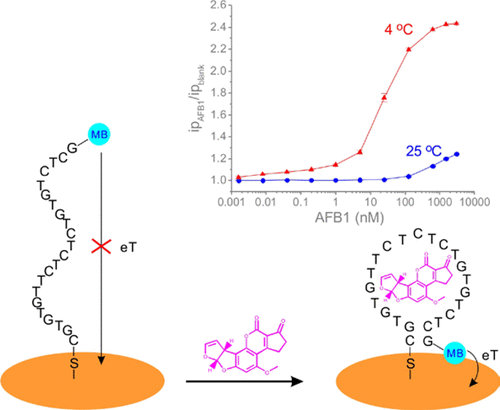Our official English website, www.x-mol.net, welcomes your
feedback! (Note: you will need to create a separate account there.)
Low Temperature Greatly Enhancing Responses of Aptamer Electrochemical Sensor for Aflatoxin B1 Using Aptamer with Short Stem
ACS Sensors ( IF 8.2 ) Pub Date : 2020-10-14 , DOI: 10.1021/acssensors.0c01572 Chao Wang 1, 2 , Liying Liu 1, 2 , Qiang Zhao 1, 2, 3
ACS Sensors ( IF 8.2 ) Pub Date : 2020-10-14 , DOI: 10.1021/acssensors.0c01572 Chao Wang 1, 2 , Liying Liu 1, 2 , Qiang Zhao 1, 2, 3
Affiliation

|
Aflatoxin B1 (AFB1), one of the most toxic mycotoxins, poses great health risks. Rapid and sensitive detection of AFB1 is important for food safety, environment monitoring, and health risk assessment. We report here the development of a simple and reusable electrochemical aptasensor for rapid and sensitive detection of AFB1. Main improvements were achieved through engineering an aptamer containing a short stem-loop structure and enhancing the binding affinity at a lower temperature. The DNA aptamer with a methylene blue (MB) label at one end was immobilized on a gold electrode. Upon AFB1 binding, the aptamer folded into a stem-loop structure and brought MB close to the electrode surface, resulting in increases in electric current. The aptamer having a shorter stem (2–4 bp) underwent a larger conformation change upon target binding. The sensors built with the aptamer containing a 2 bp stem generated much higher signal-on responses to AFB1 at 4 °C than at room temperature (25 °C). The improvements resulted in a detection limit of 6 pM, enabling the determination of trace AFB1 in a complex sample matrix. This study demonstrates that low temperature greatly enhances the performance of aptamer electrochemical sensors. This aptasensor is simple to construct and readily regenerated by washing with deionized water for reuse. This aptasensor strategy could be applied to the development of an electrochemical aptasensor for other targets.
中文翻译:

短杆适体的低温极大地增强了黄曲霉毒素B1的适体电化学传感器的响应
黄曲霉毒素B1(AFB1)是毒性最高的霉菌毒素之一,对健康构成极大威胁。快速,灵敏地检测AFB1对食品安全,环境监测和健康风险评估至关重要。我们在这里报告了一种简单且可重复使用的电化学适体传感器的开发,用于快速,灵敏地检测AFB1。通过改造包含短茎环结构的适体并在较低温度下增强结合亲和力,实现了主要改进。一端带有亚甲蓝(MB)标签的DNA适体被固定在金电极上。在AFB1结合后,适体折叠成茎环结构,使MB靠近电极表面,导致电流增加。茎短(2-4 bp)的适体在结合靶标后发生了较大的构象变化。用包含2 bp茎的适体构建的传感器在4°C时比在室温(25°C)时对AFB1产生更高的信号响应。改进后的检测限为6 pM,从而可以测定复杂样品基质中的痕量AFB1。这项研究表明,低温极大地提高了适体电化学传感器的性能。该适体传感器易于构建,并易于通过用去离子水洗涤以进行再生以重新使用。该适体传感器策略可以应用于针对其他靶标的电化学适体传感器的开发。能够确定复杂样品矩阵中的痕量AFB1。这项研究表明,低温极大地提高了适体电化学传感器的性能。该适体传感器易于构建,并易于通过用去离子水洗涤以进行再生以重新使用。该适体传感器策略可以应用于针对其他靶标的电化学适体传感器的开发。能够确定复杂样品矩阵中的痕量AFB1。这项研究表明,低温极大地提高了适体电化学传感器的性能。该适体传感器易于构建,并易于通过用去离子水洗涤以进行再生以重新使用。该适体传感器策略可以应用于针对其他靶标的电化学适体传感器的开发。
更新日期:2020-10-25
中文翻译:

短杆适体的低温极大地增强了黄曲霉毒素B1的适体电化学传感器的响应
黄曲霉毒素B1(AFB1)是毒性最高的霉菌毒素之一,对健康构成极大威胁。快速,灵敏地检测AFB1对食品安全,环境监测和健康风险评估至关重要。我们在这里报告了一种简单且可重复使用的电化学适体传感器的开发,用于快速,灵敏地检测AFB1。通过改造包含短茎环结构的适体并在较低温度下增强结合亲和力,实现了主要改进。一端带有亚甲蓝(MB)标签的DNA适体被固定在金电极上。在AFB1结合后,适体折叠成茎环结构,使MB靠近电极表面,导致电流增加。茎短(2-4 bp)的适体在结合靶标后发生了较大的构象变化。用包含2 bp茎的适体构建的传感器在4°C时比在室温(25°C)时对AFB1产生更高的信号响应。改进后的检测限为6 pM,从而可以测定复杂样品基质中的痕量AFB1。这项研究表明,低温极大地提高了适体电化学传感器的性能。该适体传感器易于构建,并易于通过用去离子水洗涤以进行再生以重新使用。该适体传感器策略可以应用于针对其他靶标的电化学适体传感器的开发。能够确定复杂样品矩阵中的痕量AFB1。这项研究表明,低温极大地提高了适体电化学传感器的性能。该适体传感器易于构建,并易于通过用去离子水洗涤以进行再生以重新使用。该适体传感器策略可以应用于针对其他靶标的电化学适体传感器的开发。能够确定复杂样品矩阵中的痕量AFB1。这项研究表明,低温极大地提高了适体电化学传感器的性能。该适体传感器易于构建,并易于通过用去离子水洗涤以进行再生以重新使用。该适体传感器策略可以应用于针对其他靶标的电化学适体传感器的开发。

































 京公网安备 11010802027423号
京公网安备 11010802027423号